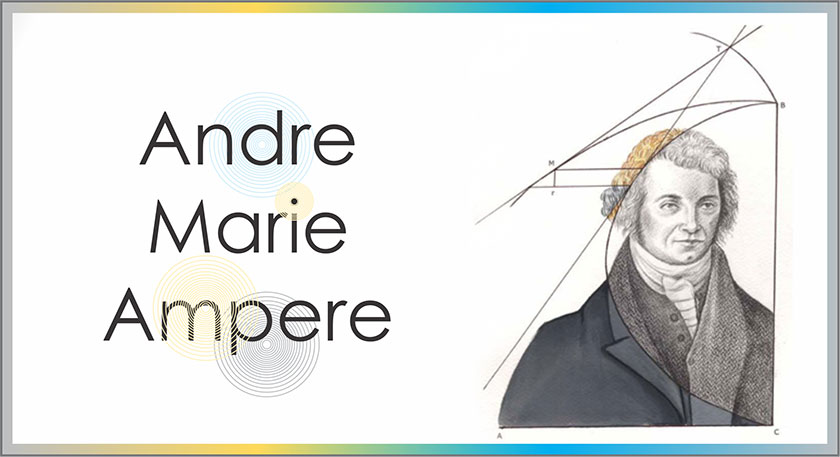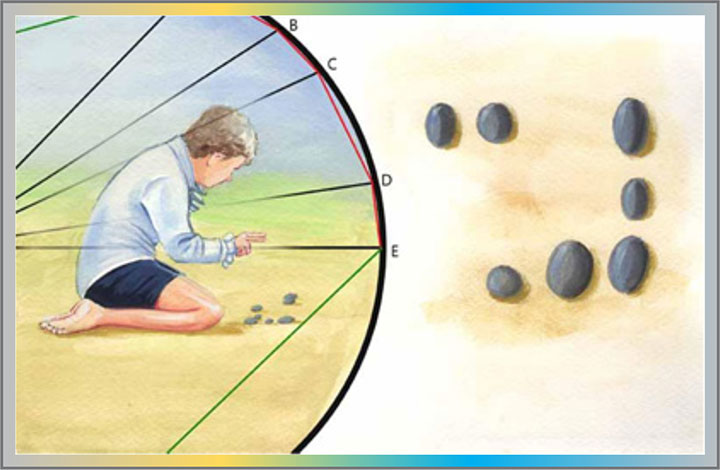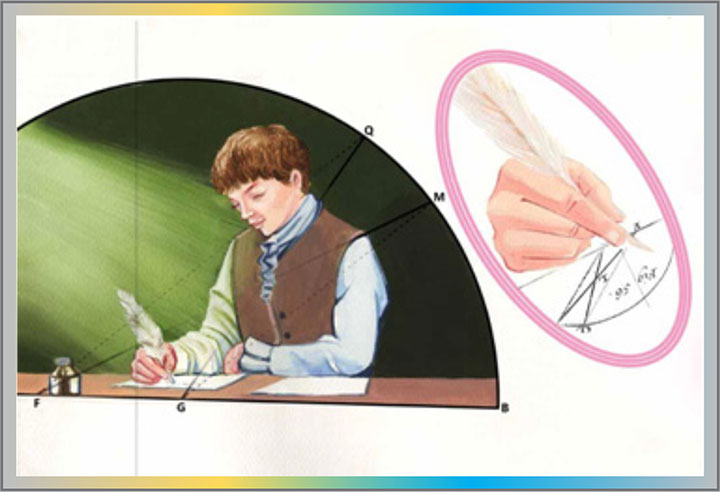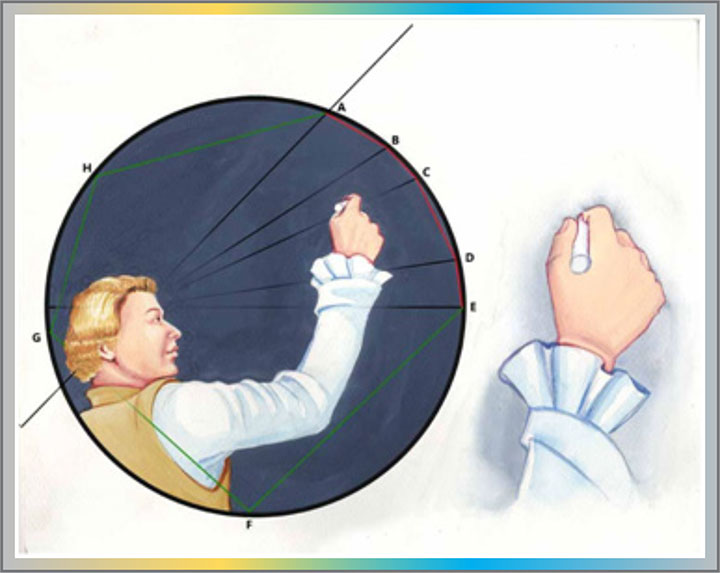
Andre Marie Ampère was the first person to study electrodynamics and discover electromagnetism. He is credited for the invention of a vital component of the modern astatic galvanometer, the astatic needle. He was the first to determine how was generated when two parallel wires are charged with electricity.
Ampere was a voracious reader and mostly self-taught. His passion for science brought him the greatest of honours and accolades that very few people ever achieved. He is better known for his accurate calculations in measuring the flow of current. Later on, to honour his contributions, the term ampere was given to a single unit of electric current. He was, without a doubt, a gifted intellectual who researched in a variety of disciplines. He excelled in chemistry and successfully came up with the classification of elements. He did excellent work on the theory of refraction of light as well. On the whole, he spent his whole life in conducting experiments, researching and studying mathematics, physics, chemistry, and philosophy of these sciences. Let us go back to the beginning, to the day he was born and trace his life’s achievements, the travails and the times.

In the beautiful city of Lyon in France, a young couple, Jeanne Antoinette Sarcey de Sutieres and Jean-Jacques Ampere joyously welcomed the birth of their bonny baby boy, Andre-Marie Ampere on the 20th January, 1775. Jean Jacques Ampere was a prosperous silk merchant and owned a country house in Poleymieux au Mont D’Or, just 10 kilometres from their primary home at Lyon. Apart from the silk business, he had also studied law and owned a huge library of books comprising the works of Rousseau, Denis Diderot, Jean le RondD’Alambert and many more. Not much is known about his mother except that she was a devout Christian and hence he too was brought up in the catholic faith. The family would spend most time of the year in Lyon except for summer when they would retire to their country house in Poleymieux.
At an early age, Ampere proved himself to be a prodigy in maths, when he would devise unique ways to learn numbers using pebbles and breadcrumbs.

Initially, he did attend a primary School at Lyon, though there is not much information as regards to the duration of his attendance.
His father, Jean-Jacques, was an ardent admirer of Rousseau, whose thoughts on education were outlined in his work Émile, and became the basis of Ampère’s education. Rousseau had argued that children should avoid formal education and instead, pursue “direct education from nature.” Jean-Jacques put this into practice by allowing his son to educate himself within the walls of his well-stocked library. Enlightening masterpieces by masters such as Georges-Louis Leclerc, Comte de Buffon’s Histoire naturelle, générale et particulière (begun in 1749) and Denis Diderot, and Jean Le Rond d’Alembert’s Encyclopédie (volumes added between 1751 and 1772) thus became Ampère’s schoolmasters. As he grew up, his father decides to permanently reside in Poleymieux so that Ampere receives the desired knowledge from the beauty of nature.

Ampere never attended any secondary School and the lush natural surroundings of his country home in Poleymieux, inspired in him the desire to gain more knowledge. It was an ideal location for his intellectual pursuits as he would endlessly walk around the woods, marvelling at its greenery, and memorizing poetries. He was so mesmerized by the beauty of nature, that he would disguise himself in a romantic image, and believed nature to be a mirror of our emotional self. Ampere, much later, describes the adolescence years, spent in the lap of nature, as the best time of his life.
Apart from nature, easy access to his father’s huge library, proved instrumental in gaining intellectual expertise pertaining to science, mathematics, philosophy and literature. Ampere read widely on books written by known authors of those times- Jean Racine, Francois Marie Arouet, also known as the famous Voltaire and the classical poetries of Virgil. He also showed keen interest in history and politics, especially the ongoing war of American Independence where the French Government provided military support to the American soldiers. The political conflict then, had a huge impact on Ampere’s life later on, and explained his controversial sentiments towards the French Revolution.

Besides classical poetry and literature, he developed keen interest in science at the age of 13. While exploring his father’s vast library, Ampere stumbled upon ‘Abrege des elements de mathematiques’ written by Dominique-Francois Rivard and Elements d’arithmetique, d’algebre et de geometric by Jean-Mathurin Mazeas. Now aged 12 and with no formal educational background, Ampere completed his academic pursuits in arithmetic, algebra and geometry without following any chronological pattern. He completely grasped all books and papers on conic branch of mathematics, and was impressed with the works of Jean-Baptiste de LaChapelle’sTraitesur les sections coniques and Gillaume de L’ Hopital’sTraiteanalytique des sections coniques. After elaborate research and study, he decided to develop a new division in conics. In mathematics, a conic is a curve obtained as the intersection of a cone with a plane.
Our young math genius then wrote his first mathematical paper, titled ‘Sur la rectification d’un arc quelconque de cercle plus petit que la demi-circonference’, at a tender age of 13.

How incredible! His work primarily laid emphasis on the complex problem of constructing a line of the same length as that of an arc of a circle. He confidently submitted his papers to the Academie de Lyon, but was disappointed as the paper was not published. The reason cited by the Academie was the use of infinitesimals (part of mathematics associated with finding tangent lines to curves), and not differential calculus, which made Ampere’s paper worthless. However the Academie was stunned by young Ampere’s brilliance in mathematics and encouraged him to continue with his research further.

Ampere’s inability to comprehend calculus, prompted his father to find a suitable tutor to educate his son on the subject. He soon found the right tutor in Professor Daburon from Le College de la Trinite, and also Inspector General des etudes at Lyon. Professor Daburon was amazed by Ampere’s intelligence and was astonished by the young man’s drive to learn more on mathematics and science without having any assistance from outside. He readily accepted the offer to privately coach Ampere, at the latter’s residence in Poleymieux. At the same time, Ampere’s father would accompany him to Lyon, once in a month, so that he could participate in lectures delivered by Joseph Mollet, a Science professor of the same College de la Trinite. Professor Mollet encouraged Ampere to read books on science particularly ‘Sur la Botanique’ by Rousseau. Both the professors played key roles in nurturing and developing Ampere’s passion for science and math’s.
When he was 16 years of age, Ampere was deeply involved in the study of ‘La Mecaniqueanalytique’ by Joseph Lagrange, when the French Revolution shattered his life completely. Initially the crisis did not affect his home region at Poleymieux much, but by the end of July 1791, the town was drawn into the tentacles of the uprising. Ampere’s father was elected as the Justice of the Peace, for the city of Lyon, but he refused to adhere to the rules and regulations stipulated by the authorities of National Convention at the capital city of Paris. The innocent civilians of Lyon rebelled against the authorities, and the entire city was placed under siege. Ampere was deeply anguished by the uncivilized political siege of Lyon. Eventually after months of civil war, causing widespread destruction of life and property, the city of Lyon was won over by the National Convention.
Catastrophe struck when Ampere’s father was found guilty of conspiracy, and condemned to death. Ampere was shocked beyond words and his whole world fell apart. The death of his father had a devastating effect on the mind of Ampere.

The French revolution had traumatized Ampere to such an extent, that he suffered a nervous breakdown. The profound sorrow and grief at losing his father, by far overshadowed his passion for reading and pursuing academics. Torn apart and in a melancholic state, he would aimlessly wander in the woods and the hills of his countryside home. He began to write poems, criticizing the ruthless politics and found solace in Rousseau’s work on botany.
It was only love that came to his rescue during this misery. Yes, Ampere’s life blossomed when he met Julie Carron and he was totally smitten by her beauty. Although she found him awkward, shy and poorly presented, the two eventually got married in married 1799.

The young couple began their marital life in Lyon, and soon Ampere realized the need to be suitably employed. He began his career as a tutor of mathematics in Lyon at the age of 22. Within a short span of two years, he became a proud father to Jean Jacques and his life was filled with joy and happiness. He continued in the profession of tutoring, and by the time he was 25 years old, he was appointed as professor of physics and chemistry at Bourg Ecole Centrale. However at the same time, Julie fell sick and Ampere was forced to leave her and their son at Poleymieux and proceed to Bourg Ecole Centrale alone.


In Bourg, Ampere spent most of his time teaching physics and chemistry, but his interest was in mathematics. After comprehensive research and study, he formulated a treatise on probability titled, ‘The Mathematical Theory of Games’, which was duly submitted to the Paris Academie. After few modifications and corrections the treatise was finally printed. By the time he was 28 years old, he began to work on the ‘Calculus of Variation’. At this time, he also came into contact with Joseph Delambre who was 26 years his senior, a great astronomer and mathematician and an influential personality in Napoleon Bonaparte’s Empire.
As Ampere progressed in his work by publishing another paper titled, ‘Les considerations sur la theorie mathematique du Jeu’, Julie’s health deteriorated forcing young Ampere to move to Lyon. This was made possible only due to influence of Joseph Delambre, who had him appointed him as a mathematician in Lycee in Lyon. However it was too late, as Julie succumbed to her illness (not known) and he was left alone with the responsibility of their son, Jean Jacques. The death of his wife made him feel guilty of not having spent quality time with her, and he decided to leave Lyon and move to Paris.

The thought of beginning life afresh in Paris, brought some semblance of cheer into his otherwise dull life. Joseph Delambre again played a pivotal role and helped Ampere bag the position of Analysis Tutor in the Ecole Polytechnique. Ampere began to look upon Delambre as a paternal figure, as he helped him to get adjusted to the Parisian academic life. As time progressed, Ampere was promoted as a member, and then secretary of the Bureau Consultative des Arts et Manufacturers, General Inspector of Studies and eventually a teacher at Ecole Polytechnique.
Ampere spent most of his time in preparing notes for his lessons on physics and chemistry, and also toured parts of France as Inspector of Studies. He also conducted research on the branch of calculus of variation and submitted a paper on partial differential equation to the mathematical department of L’Academie des Sciences. By the age of 32, he had gained reputation as a proficient teacher in mathematics and as a brilliant research mathematician. Around the same time, his personal life took a twist when he married for the second time to Jenny on 1st August 1806, but the marriage proved to be a disaster. Within two years of marriage, cracks developed in their relationship and even the birth of their daughter Albine, could not save their holy matrimony. The couple eventually sought legal separation and Albine’s custody was awarded to Ampere, who was now 34 years of age.
Ampere moved on in life, and after having displayed his brilliance in mathematics, decided to devote his attention to chemistry, more specifically the classification of elements which he successfully accomplishes. By the age of 41, he begins to research on the theory of light and publishes a paper on ‘Refraction of Light’.

As Ampere’s interest in light and electricity grew, he heard about the Hans Christian Oersted’s experiments on electromagnetism and was inspired. He began to conduct serious research on electricity and made an important discovery. He developed a unique instrument using a needle, to measure the exact flow of electric current called galvanometer. It resembles a compass where a wire is wrapped around the needle and connected to a source of power, in this case a battery. If the needle deviates it shows current is created. The greater the flow of current the more the needle deflects.
Over the next few years he continues with his research on metaphysics and electrodynamics, and is assisted by Felix Savary a fellow student in Ecole Polytechnique to write the results of his experiments. Drawing inspiration from Ampere, a few other scientists like Michael Faraday, Weber and Maxwell conducted several experiments on the relation between electricity and magnets. After tremendous hard work, research and study, Ampere developed a formula to calculate the magnetic forces caused by electricity. The formula was called the Ampere law. At the age of 47, his work titled ‘Memoir on the Mathematical Theory of Electro-dynamic Phenomena’ was published. The law states that when an electric current flows through two parallel wires, they produce a magnetic field on each other. If the flow is in the same direction, they will attract each other and if the parallel current flow is in the opposite direction, then they will repel. Ampere quickly submits his work to the Academy, and conducts several demonstrations on various magnetic and electrical effects for the authorities.
As time progressed, Ampere is appointed as a teacher of mathematics at the College de France. Here he enjoys the liberty to introduce his personal research and writings, rather than those stipulated in Ecole Polytechnique’s syllabus. He is joined by his disciple, Liouville from Ecole Polytechnique who assisted Ampere in editing his notes on electrodynamics at College de France.

Ampere never enjoyed a blissful life as a string of tragedies, one after another always marred his domestic life. He shared a complex relationship with son Jean-Jacques and their different temperamental nature, often resulted in heated exchange of anger and abuse. However his son proved to be a literary genius, and gained world-wide fame on his own steam, as a historian in the later years. Ampere’s daughter married a lieutenant from Napoleon’s army, but the union proved catastrophic as he was an incorrigible alcoholic. She left her husband and came to live with her father once again, and peace once again eluded Ampere’s Poleymieux home. After a few years, his son-in-law too joined them and Ampere had to face a lot of accusations and flak from society, causing him to become severely depressed.
Ampere continued to work in the capacity of teacher and General Inspector of Studies, which took heavy toll on his health as he had to travel regularly. In spite of his frail health and ripe old age of 61, he was asked to perform his duties as an Inspector at College Royal in Marseille, France. On his arrival at Marseille his health deteriorated and after preliminary medical examination, he was diagnosed with severe pulmonary infection. He was advised bed rest for the remaining years of his life. He continued to be read papers on history and philosophy lying in a bed in the Principal’s apartment. He passed away in solitude on the morning of 10th June 1836, far away from his family, and the comfort of his Poleymieux home. Only a few close professors of the Marseille Academy and some officials from the ministry of education attended his funeral. Other elite and social personalities chose to abandon the funeral of this great genius who formulated the laws of electromagnetism and brought honour to his country. He was quietly buried in a cemetery of Saint Charles in Marseille, and after 30 years post his demise, his remains were relocated to Montmartre Cemetery in Paris to be buried along with his son.

"He loved the human kind; he was simple, good and grand." This was the simple epitaph on his tombstone. Ampere was an ordinary man who led a simple life without craving for any material comforts. Science was his passion, and every breath was devoted in scientific pursuits. Although he never possessed a formal degree from any educational institution, it never hampered his efforts to know more. Books and nature were his best friends, and he strongly believed that knowledge is the key to wealth and prosperity of a nation. Unfortunately his country did not realize his invaluable contribution to the field of science then.
Nearly 50 years after his death, Gustave Eiffel built the famous Eiffel Tower in the year 1889 and included the name of Andre Marie Ampere among the 72 prominent French Scientist on a plaque at the base of the structure. The entire science fraternity across the globe have recognized his work on electromagnetism, and rightly conferred the title of ‘THE NEWTON OF SCIENCE’ on him.
Biography of Andre Marie Ampere | 0 Comments >>
0 --Comments
Leave Comment.
Your email address will not be published. Required fields are marked.

